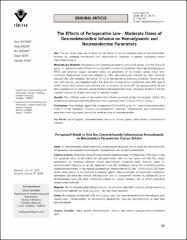The effects of perioperative low- moderate doses of dexmedetomidine infusion on hemodynamic and neuroendocrine parameters
Künye
Kaymak, Ç., Başar, H., Doğancı, N., Sert, Ö., Apan, A. (2008). The effects of perioperative low- moderate doses of dexmedetomidine infusion on hemodynamic and neuroendocrine parameters. Turkish Journal of Medical Sciences, 38(1), 65 - 71.Özet
Amaç: Bu çalışmanın amacı elektif transuretral cerrahi yapılan hastalarda, orta ve düşük doz dexmedetomidin infüzyonunun, hemodinamik ve nöroendokrin parametrelere olan etkisinin incelenmesidir. Yöntem ve Gereç: Randomize olarak 50 hasta, anestezi indüksiyonundan 10 dakika önce 0.45 (Grup 1) veya 0.6 ug/kg/saat (Grup 2) dexmedetomidin infüzyonu aldılar. Kalp hızı, kan basıncı, end-tidal CO2, oksijen satürasyonu, ve noninvaziv kardiyak output parametreleri monitorize edildi. Ölçümler, bazal (I), dexmedetomidin infüzyonu sonrası (II), tiyopental sonrası (III), entübasyon sonrası (IV) ve desfluran anestezi uygulaması boyunca her 10 dakikada bir gerçekleştirildi. Anestezi idamesi (2L dak"1, % 50 N2002), BİS değeri 40-60 olacak şekilde, % 4-6 desfluran kullanılarak sağlandı. Plazma adrenalin ve noradrenalin seviyelerinin belirlenmesi için venöz kan örnekleri, entübasyondan önce (I), intraoperatif dönemin 30. dakikasında (II) ve ekstübasyondan sonra (III) alındı. İstatistiksel analizde Chi- Square, Student-t test ve tekrarlı ölçümlerde varyans analizi kullanıldı. Bulgular: Her iki dexmedetomidin infüzyonu benzer hemodinamik değişiklikler oluşturdu. Kardiyovasküler ve nöroendokrin değereler ise, Grup 2'de; Grup l'den daha fazla baskılandı. Sonuç: Bu bulgularla, intraoperatif 0.45 ve 0.6 ug kg"1 saat"1 doz dexmedetomidin benzer hemodinamik yanıt oluşturmuştur. Kardiyovasküler ve nöroendokrin parametreler, orta doz dexmedetomidin ile daha fazla hastalanmaktadır. Aim: The aim of this study was to determine the effects of low and moderate doses of dexmedetomidine infusions by evaluating hemodynamic and neuroendocrine responses in patients undergoing elective transurethral surgery. Materials and Methods: Fifty patients were randomly allocated to receive 0.45 (Group 1) or 0.6 (Group 2) ug kg"1 hr"1 dexmedetomidine infusion 10 minutes before induction of anesthesia. Heart rate, blood pressures, ETC02 and peripheral oxygen saturation values and parameters of non-invasive cardiac output were monitored. Measurement times were baseline (I), after dexmedetomidine infusion (II), after thiopental induction (III), after intubation (IV) and at 10-minute intervals during desflurane anesthesia. Anesthesia (2L min"1 50% N2002) was maintained with 4-6% desflurane corresponding to a bispectral index (BIS) value of 40-60. Venous blood samples were collected prior to intubation (1), at the 30th min intraoperatively (II) and after extubation (III) to determine plasma adrenaline and noradrenaline levels. Chi-square, Student's t-test and repeated measures of variance were used for statistical analysis. Results: Two different doses of dexmedetomidine infusion produced similar hemodynamic effects. The cardiovascular and neuroendocrine parameters were suppressed more in Group 2 than in Group 1. Conclusions: These findings suggest that intraoperative 0.45 and 0.6 ug kg"1 hr"1 doses of dexmedetomidine result in similar intubation, recovery and hemodynamic responses. Cardiovascular and neuroendocrine parameters were suppressed more by the moderate dose of dexmedetomidine.
Kaynak
Turkish Journal of Medical SciencesCilt
38Sayı
1Bağlantı
https://app.trdizin.gov.tr/publication/paper/detail/TnpnNE16azU=https://hdl.handle.net/20.500.12587/378
Koleksiyonlar
- Makale Koleksiyonu [162]
- TR-Dizin İndeksli Yayınlar Koleksiyonu [3218]
















